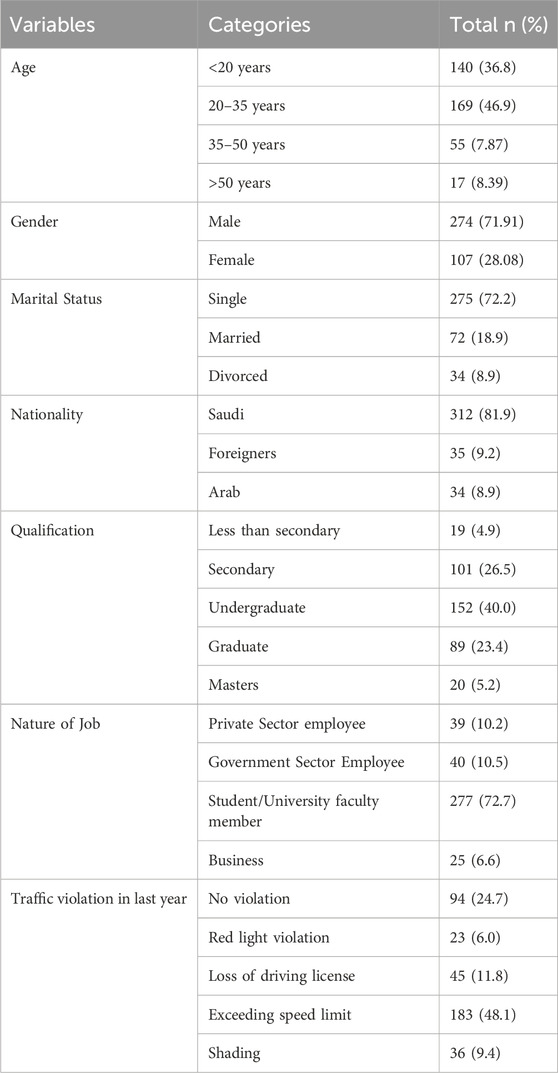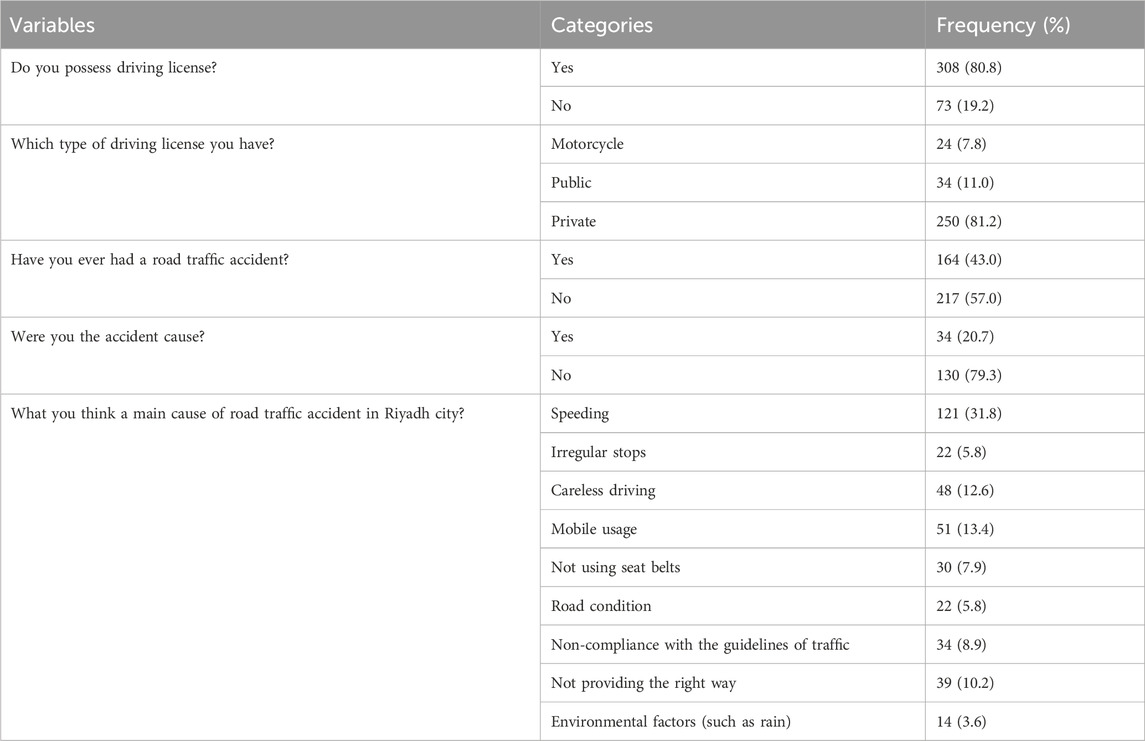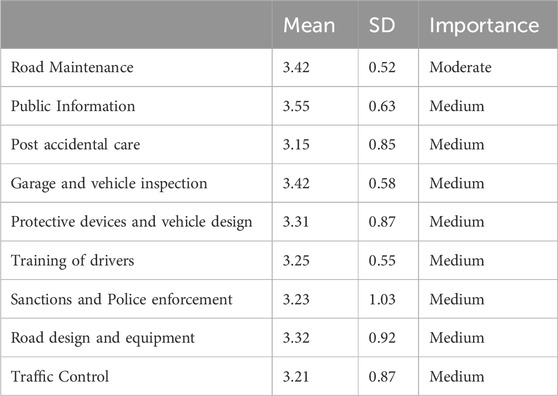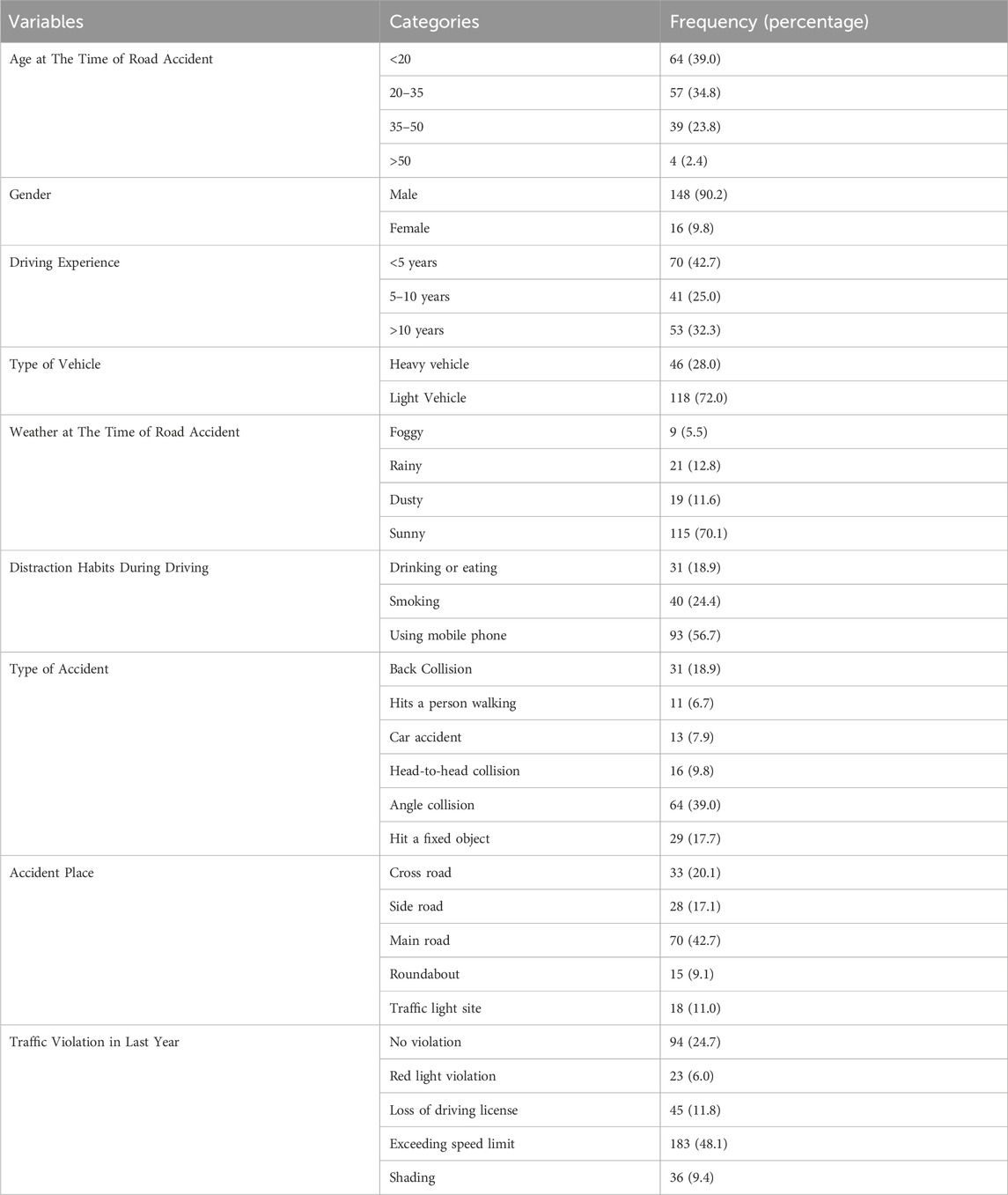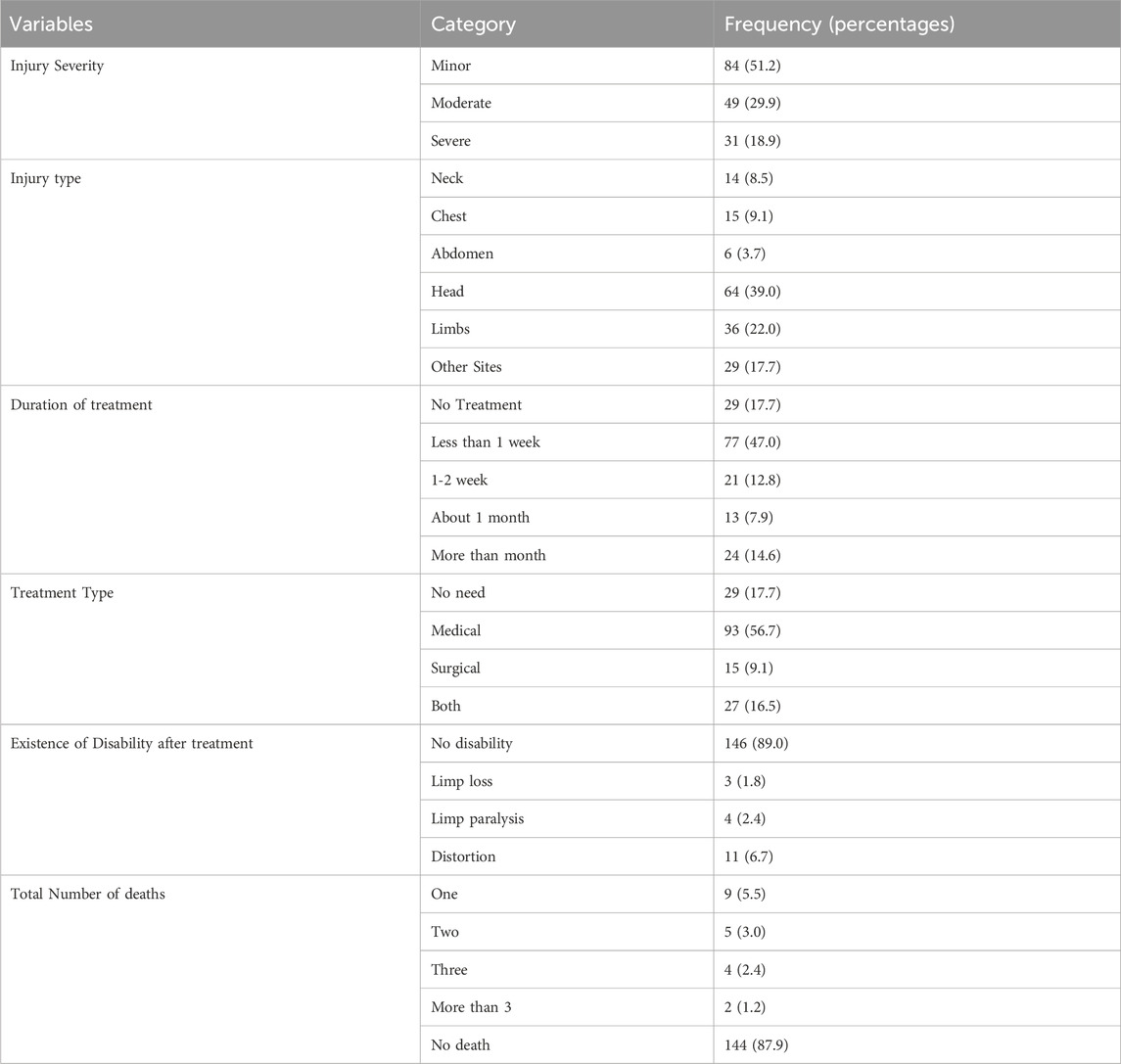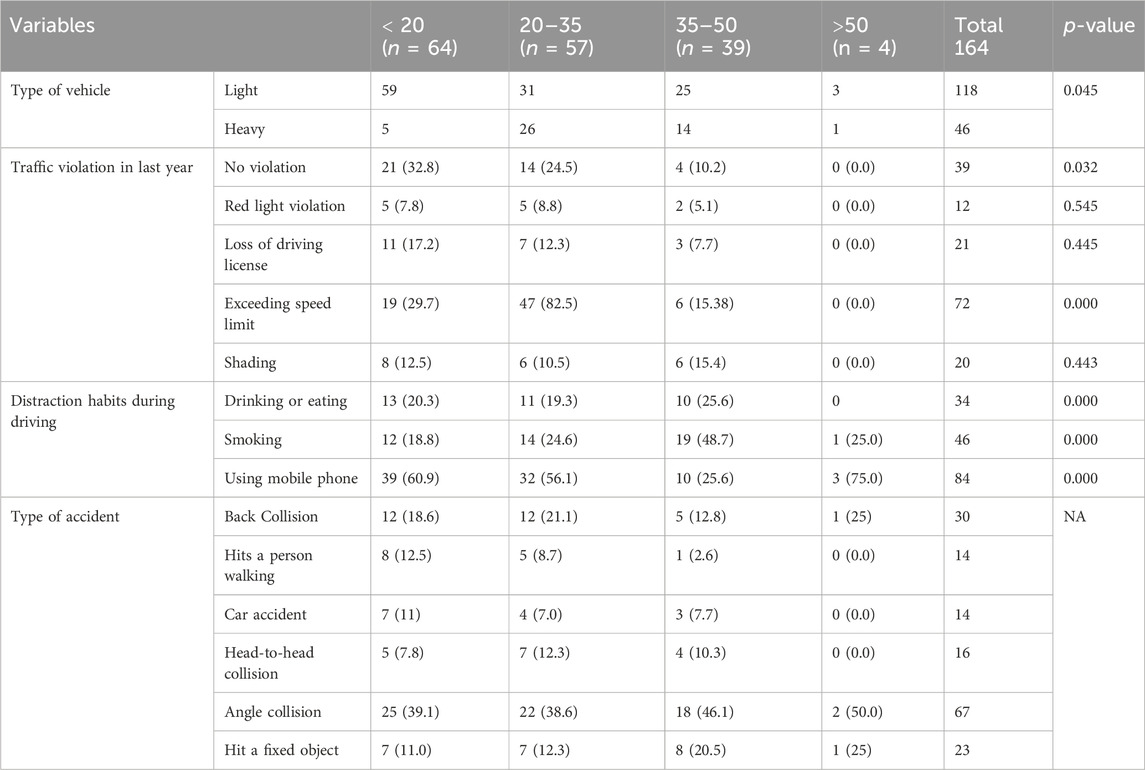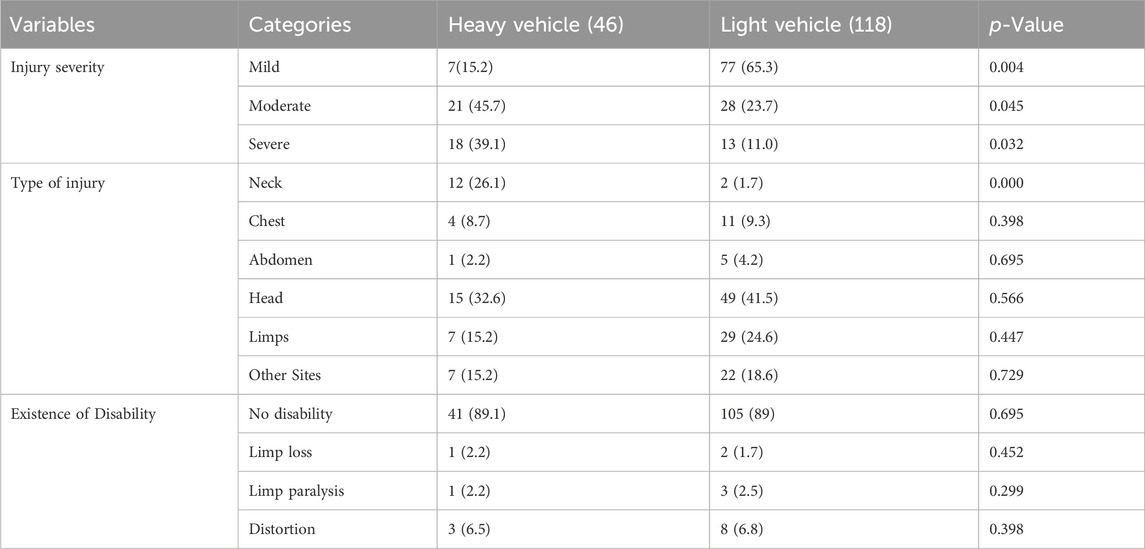Perception of drivers toward road safety and factors that cause road accidents in Riyadh city of Saudi Arabia
- Department of Urban and Regional Planning, College of Architecture and Planning, Imam Abdulrahman Bin Faisal University, Dammam, Saudi Arabia
Injury as a result of road traffic accidents (RTA) is one of the leading causes of death and disability-adjusted life years. Strategies to handle this major public health problem, which has significant consequences for the Saudi economy and families, have been underway for many years but with very little success. This study’s main aim is to determine respondents’ perceptions of traffic safety and the factors that lead to road traffic accidents. It is a cross-sectional study conducted on randomly selected university students, faculty drivers, and visitors using King Saud University’s parking facility. Data were collected from 381 drivers using a pretested questionnaire, which comprises questions intended to attain the study’s objectives. The critical factors affecting traffic safety are public information followed by road maintenance, Garage, vehicle inspection, Road design and equipment, Training of drivers, Sanctions and Police enforcement, Protective devices and vehicle design, and post-accidental care. Road traffic accidents were found to be 39.0% with respondents aged less than 20 years, followed by ages between 20–35 years, which was 34.8%, and only 2.4% above 50 years. The most frequent occurrence of road traffic accidents was angle collision (39.0%) and back collision (18.9%), followed by hitting a fixed object (17.7%). Distraction habits during driving include cell phone usage (56.7%), followed by smoking (24.4%), and eating and drinking (18.9%) while driving. The most common traffic violations were increased speed limit (48.1) and loss of driving license (11.8%). The most common injuries were head (39.0%) and limbs (22.0%). A significant association between drivers’ age during the accident and distraction habits has been found (p < 0.000). The study demonstrated that drinking/eating, cell phone use, and violation of traffic rules are significant reasons for RTA. The findings of this study will contribute to a more comprehensive knowledge of road traffic accidents for the formation of effective strategies and evidence-based policies for the prevention of accidents.
1 Introduction
Road traffic accidents (RTA) are a leading cause of hospital admissions worldwide (Bener, 2012). According to the World Health Organization (WHO), injuries as a result of road accidents are the tenth most common reason for disability-adjusted life years (DALYs) (Murray et al., 2013; Fumagalli et al., 2017). According to literature, Road traffic accidents end in the deaths of approximately 1.35 million people each year around the world, which is expected to increase further by 2025 (Ahmed et al., 2023). Among them, more than half of all road traffic deaths occur in vulnerable road users, such as pedestrians, cyclists, and motorcyclists (Ahmed et al., 2023). This trend demonstrates that road traffic fatalities are above the target set under the sustainable development goals (Ahmed et al., 2023). In Saudi Arabia, fatalities due to road accidents are a significant cause of concern, accounting for 4.9% of all mortalities. In contrast, road traffic mortalities in the UK, the US, and Australia do not exceed 1.5% (Mansuri et al., 2015; Asiri et al., 2021). Over the last few years, road fatalities in Saudi Arabia have increased significantly from 16.3–25 per 100,000 population to 5 in the UK and 10 in the United States, where all primary and secondary road safety measures have been taken seriously (Mansuri et al., 2015; Asiri et al., 2021). In 2016, in Saudi Arabia, more than 9000 road traffic fatalities were reported, which means the death of one person per hour (Al-Tit et al., 2020). The impact of road accidents is on drivers, their families, and the whole society and also cause significant economic losses besides fatalities and injuries (Al-Tit et al., 2020).
Riyadh, the capital of Saudi Arabia, presents a unique context for studying traffic safety due to its extensive population growth and rapid urbanization in the last few decades (Aldalbahi et al., 2015; Alshammari, 2019). With its expanding population and urban footprints, Riyadh City has experienced significant development in infrastructure, such as the construction of a transportation system and a modern network of roads. The road network of Riyadh city comprises arterial roads, urban streets, and highways, which reflect its status as the central cultural and economic hub (Aldalbahi et al., 2015; Alshammari, 2019). In addition, the traffic patterns of Riyadh city demonstrate a distinctive characteristic mainly influenced by different factors such as urban sprawl, economic activities, and population density (Alshammari, 2019). Unlike Western countries, Riyadh’s transportation system is primarily shaped by the combination of public transportation, private vehicles, and traditional transportation modes, thus leading to diverse traffic dynamics (Alshammari, 2019). In addition, in Riyadh City, the regulatory framework that governs traffic safety comprises mechanisms of enforcement and traffic laws designed for the specific challenges and needs of the city. In Riyadh city, various factors influence traffic safety, demanding a need to understand the city’s transport system (Mansuri et al., 2015). For example, the rapid urbanization in Riyadh city has led to various road hazards, such as an increased risk of accidents and a lack of pedestrian infrastructure (Mansuri et al., 2015). In addition, certain drivers’ behaviors, such as noncompliance with regulations and speeding, are prominent in the traffic culture, thus posing specific safety risks. Cultural norms also play an important role in traffic safety outcomes in Riyadh city (Alharbi, 2018). The reliance on private vehicles for daily commuting also leads to concerns about road safety and congestion (Alharbi, 2018). However, despite the increasing interest in traffic safety research, the literature on traffic safety in Riyadh City remains scarce, with several limitations and gaps. Traffic accidents have been the focus of many studies on road safety in Saudi Arabia, focusing mainly on improving road traffic safety. However, efforts must be made to understand drivers’ behavior in Saudi Arabia and what motivates them to adhere to traffic rules. Different studies conducted in other developed countries, mainly in Europe and the US, show that findings from these countries cannot be wholly generalizable to Saudi Arabia due to its unique culture. Therefore, this study is carried out with the main aim of augmenting previous studies and addressing road safety in different dimensions, such as protective devices, traffic education, road design, post-accident care, police sanction, maintenance of the road, and vehicle design, which have not received significant attention from researchers in the past.
2 Literature review
Different studies have been carried around the world that discusses the road traffic accidents. Timmermans et al. (2019) conducted a survey in Qatar to determine professional driver’s unsafe behavior. The findings showed that professional drivers are usually distracted by their phones and break laws near schools (Timmermans et al., 2019). In China, road fatalities have decreased since 2015. This was reported in a study conducted by Wang et al. (2019), in which authors analyzed the national database. Using a severity index (case fatality rate and human damage), it was found that despite the reduction in traffic accidents, the severity of road accidents has increased. This mechanism is mainly attributed to road design, small safety margin, nighttime driving, speeding, and freight accidents (Wang et al., 2019).
In Saudi Arabia, motor vehicles are the main means of transportation. Previous research in various regions in Saudi Arabia has demonstrated that traffic accidents in the KSA pose a significant problem that needs to be addressed. A recent report shows more than seven million cars are on KSA’s roads (Ebqa’ai & Ibrahim, 2017). According to mortality and morbidity records, 81% of the mortality and 21% of the hospital beds are occupied by road injury victims in KSA. In the last two decades, almost 611,000 injuries and 86,000 deaths have been recorded due to RTAs, with 8% resulting in permanent disabilities. It is also found that running red lights and increased speed are significant causes of road accidents. Another reason for road accidents is less compliance with seat belt use (Al Turki, 2014). A survey conducted by Gad et al. (2011) in Riyadh city found that among adolescents, road accidents are the second leading cause of injuries after falls (Gad et al., 2011). Previous studies have demonstrated that over speeding was the primary reason for many accidents. A survey by Mansuri et al. (2015), in which 24 years of published literature was reviewed, found that increased speed was the primary reason for road accidents (Mansuri et al., 2015). Khan et al. (2018) conducted a study to determine the common causes of road accidents. The most common reasons reported for road accidents include disobeying traffic laws, fatigue, carelessness, and increased speed. In contrast, underage driving, lack of patience, mobile phone use, and lack of driving education are among the less common causes (Khan et al., 2018). Another study by Alshammari et al. (2020) found that the rate of accidents is highest among youngsters. The main factors that lead to RTAs are illegal parking, speeding, and running red lights (Alshamrani et al., 2020).
Although India and Hongkong are facing similar challenges to Riyadh City in terms of rapid urbanization and population growth, some differences are present. For example, in India, road safety is a major issue, with unsafe vehicles and poor road conditions leading to more than 900,000 deaths and injuries every year (Mittal, 2008). In Hong Kong, traffic road safety is also a major issue with frequent accidents and fatalities. Hong Kong stands out with the greatest proportion of pedestrian deaths, accounts almost 67% which is of great concern (Jacobs et al., 2000). Different measures have been implemented to improve road safety, such as infrastructure improvement, mandatory use of seatbelts, campaigns related to road safety and strict traffic law enforcement. However despite these efforts, the findings have shown that the lack of comprehensive data on the traffic behavior, opinion and knowledge of road users hinders the planning of effective strategies for preventing traffic accidents (Jacobs et al., 2000; Ye, 2014).
Over the last few years, the injury or accident reporting system in Saudi Arabia has greatly improved. Speed camera systems have been installed, legislation on seat belts has been put into practice, and records of road mortalities and injuries have been significantly improved (Mansuri et al., 2015). A study was carried out in which authors addressed the safety of pedestrians in road traffic accidents. The article mainly focuses on the factors that impact the fatalities involving pedestrians in Poland. The findings of this study have highlighted the significance of pedestrian fatalities, considering the economic and social consequences related to such incidents. The factors identified in this study that are linked to the increased risk of pedestrian fatalities include speeding, demographics, driving under the alcohol influence, adverse weather conditions, and location. The findings of this study have provided valuable insights for forming interventions aimed at improving pedestrian safety within a specific region (Macioszek et al., 2023). In another study, the authors determined the factors influencing the occurrence and severity of injuries among bicyclists involved in motor vehicle crashes. The findings of this study have highlighted that the age and gender of the vehicle driver, location, type of incident, time of day, and vehicle type are the factors that contribute to these incidents.
The findings have provided excellent insight for improving bicyclist safety in traffic accidents in urban areas (Macioszek and Granà, 2021). Similarly, another study was carried out in which authors explored the main role of bicycles as a mode of transportation in Western European countries. In this study, the authors examined the services and bicycle infrastructure in selected cities in Poland, highlighting the importance of bicycle counters as a data source on the traffic volume of bicycles. This study’s findings help understand the bicycle’s traffic patterns and inform initiatives of traffic and transportation engineering (Macioszek and Jurdana, 2022). A study was carried out in which authors used Data Mining and GIS techniques that aim to find the knowledge and pattern of traffic accidents among children to prevent these accidents. The findings have shown that most of the accidents occurred during the afternoon and morning rush hours, and the most common accident that has been found is the pedestrian-vehicle collision. The factors contributing to these accidents near the schools include school location, traffic signal presence, and the speed limit (Han and Lee, 2020). Another study was carried out in which authors evaluated the distribution and pattern of injuries among pedestrians involved in fatal traffic accidents. The findings have demonstrated that factors such as the use of alcohol by drivers, illiteracy, poor awareness, and the use of highways as areas for children’s play lead to fatal traffic accidents. The determination of these factors is essential to form effective strategies to minimize fatalities, especially those occurring near universities and schools (Mandal and Yadav, 2014).
The findings of the literature review have shown that road traffic accidents present a significant public health problem around the world, with injuries and fatalities increasing at an increasing rate. As demonstrated in the literature review, human factors such as driver fatigue, risky driver behavior, and attitude toward road safety play an important role in the occurrence of an accident. Understanding people’s perception of road safety and the factors that lead to traffic accidents is essential for forming effective interventions to prevent these risks. All the above studies emphasized on the need for the public awareness programs and targeted interventions. The findings of this study will be helpful in formulating strategies that help in minimizing the road traffic accidents.
Furthermore, previous studies lack comprehensive data on the unique dynamics of the traffic environment of Riyadh city, thus limiting their applicability to local planning efforts and policy making. In addition, insufficient attention has been given to innovative strategies for traffic management in the existing literature. There is a need for further research to address these gaps and provide an understanding of urban planning initiatives and evidence-based policy in Riyadh City. Given these gaps in the literature and the great need to address the various challenges in traffic safety, it is important to carry out targeted research to form evidence-based policy decisions and strategies. This study mainly aims to fill the existing gaps in the literature by augmenting previous studies and addressing road safety in different dimensions, such as protective devices, traffic education, road design, post-accident care, police sanction, maintenance of the road, and vehicle design, which have not received significant attention from researchers in the past.
3 Methods
3.1 Study design
A cross-sectional study was carried out in Riyadh city, Saudi Arabia. This study commenced from April to July 2022 for 4 months. A survey method was adopted for its advantages, including the convenience of collecting data, ease of describing the large population characteristics, the possibility of obtaining more valid responses, and low cost. The survey method was also used so that the findings could be generalized to the whole population. This survey included licensed university students and faculty drivers using King Saud University’s parking facility, as well as stakeholders regularly visiting the university. Written informed consent was taken from all respondents willing to participate. All respondents were assured about the confidentiality and authenticity of the research. Krejcie and Morgan’s table were used to determine the sample size, resulting in a sample size of 381. Simple random sampling was used to collect this sample.
3.2 Questionnaire
A validated structured questionnaire was developed based on information collected about traffic safety and factors influencing traffic safety in Riyadh city. The initial draft was created after a comprehensive review of previous studies conducted worldwide (Sayed et al., 2022). The questionnaire was designed in both Arabic and English to facilitate easy completion by both local and foreign respondents. Pilot testing was conducted, and the questionnaire was then distributed among the final study participants (pilot study results were not included in the final analysis). A total of 395 questionnaires were completed, and all invalid or incomplete responses were excluded. After excluding these responses, 381 questionnaires formed the final study sample.
The questionnaire consists of three sections:
Section 1: The first section gathers demographic information of respondents.
Section 2: The second section addresses respondents’ perspectives on traffic safety dimensions, utilizing a 5-point Likert scale (ranging from 1—Strongly Disagreed to 5—Strongly Agreed). This section encompasses seven dimensions: vehicle design, calming traffic area-wise, road design, road maintenance, traffic education, and sanctions and police campaign.
Section 3: The third section is designed specifically for respondents who had experienced accidents, including questions related to the factors contributing to those accidents.
Face validity was confirmed through the evaluation of the questionnaire by six raters specialized in traffic safety. Reliability, assessed using Cronbach’s alpha, yielded a value of 0.75 with no modifications. The questionnaire’s validity was determined through discriminable and convergent validity, and the standardized factor loadings ranged from 0.59 to 0.86.
3.3 Data collection and statistical analysis
The data was collected in two parts. In the first part, the data was collected from all respondents to determine their perception of traffic safety dimensions in Riyadh city. In the second part of data collection, only those respondents who had already had an accident were asked to fill the third section of the questionnaire related to the road traffic accidents’ causes. The respondents were contacted and after updating them about the study, they were asked to fill the questionnaire. The Statistical Package for Social Sciences (SPSS) version 20 was used for analysis. The collected data was coded systematically and checked and verified for errors. Percentage and frequency analysis were performed for qualitative variables, while means and standard deviation were calculated for quantitative variables. To find the association between various variables, a Chi-square test was used.
4 Results
4.1 Demographic characteristics of respondents
The findings demonstrated that (46.9%) of the respondents were in the age group 20–35 years, followed by respondents less than 20 years (36.8%). Most of the respondents in this study were males (71.9%), and only 28.1% were females. Regarding the marital status of the respondents, it was found that the majority of them were single (72.2%), whereas 18.9% were married and 8.9% were divorced. The majority of the respondents were undergraduates (39.9%), while 23.4% were graduates, and 26.5% had secondary education. In terms of nationality, the majority were Saudi (81.9%), whereas 8.3% were Arabs, and 9.2% were foreigners. The majority of the students in this study were students and faculty members (72.7%) whereas 6.6% were business owners, 10.5% were government sector employees, and 10.2% were private sector employees. Demography of respondents is presented in Table 1.
4.2 Perception of drivers towards traffic safety
As shown in Table 2, most respondents in this study possess a driving license (80.8%), with the majority holding a private driving license (81.2%). According to Table 2, 43.0% of respondents had already been involved in an accident, while 57.0% had never experienced one. Only a small percentage of respondents admitted that their mistake caused the accident (10.8%). The majority of respondents (79.3%) stated that they were not the cause of the accident. The main reported causes of accidents in this study were speeding (31.8%), careless driving (12.6%), noncompliance with traffic guidelines (8.9%), not using seat belts (7.9%), mobile usage (13.4%), and environmental factors (3.6%), as shown in Figure 1 and Table 2.
4.3 Perception of respondents on traffic safety Items
The mean and standard deviation were calculated for the research question: What are the factors that impact traffic safety in Riyadh city? The total mean scores and values for all dimensions are presented in Table 3. The critical factor that is found to affect traffic safety is Public Information (Mean = 3.55, SD = 0.63), followed by maintenance of road (Mean = 3.42, SD = 0.52), Garage and vehicle inspection (Mean = 3.42, SD = 0.58), design of road and equipment (Mean = 3.32, SD = 0.92), Training of drivers (Mean = 3.25, SD = 0.55), Sanctions and Police enforcement (M = 3.23, SD = 1.03), Protective devices and vehicle design (Mean = 3.31, SD = 0.87), and Post-accidental care (Mean = 3.15, SD = 0.85) shown in Table.
4.4 Characteristics of respondents at the time of accident
Among total respondents, 164 respondents who had previously had an accident were asked to fill the third section. The results demonstrated that RTA were frequent among respondents aged less than 20 years (39.0%), followed by 34.8% in individuals between ages 20–35, 23.8% in ages between 35 and 50 years, and only 2.4% above 50 years. The results showed that most Accident occurs during sunny weather (70.1%), (12.8%) occur during rainy weather and (11.6%) during dusty weather. Regarding the distraction habits at the time of driving, findings showed that (56.7%) use mobile phones during driving, (24.4%) and (18.9%) eat or drink. The highest occurrence of traffic accidents was angle collision (39.0%), followed by back Collison (18.9%) and striking a fixed object (17.7%). The results of this study showed that the most of the RTA occurred on the main road (42.7%), followed by crossroads (20.1%) and side roads (17.1%) shown in Table 4.
4.5 Description of RTI related injuries and treatment
Table 5 shows the severity and type of injury and treatment, disability after treatment and number of deaths resulting from RTA. The results showed that most of the injuries were minor (51.2%) whereas (29.9%) were moderate, and (18.9%) were severe. The most common injuries were limps (35.4%) and head (25.6%). In (47.0%) of the cases, the duration of treatment was less than 1 week, whereas treatment was more than a month in (14.6%) of the cases. In the majority of the cases, treatment was medical (56.7%), whereas (9.1%) was surgical, and in (16.5%), it was both. No treatment was needed in 17.7% of the cases. No disability was seen after treatment among (89.0%) of the cases, (and 6.7%) suffered from distortion. The findings showed that no death was seen in (87.8%) of the cases.
4.6 Association between age at accident time, distraction habit and violation of traffic rules
A Chi-square test was used to know the relation between age at the accident time and distraction habits, violation of traffic rules in last 1 year and type of accident. The results showed a significant association between drivers' age and distraction habits (p < 0.000). No significant association has been found between the driver’s age at the time of the RTA and the traffic violation last year, as shown in Table 6.
4.7 Association between type of vehicle, injury severity, type and disability
The Table 7 demonstrated an association between type of vehicle and road traffic injury severity, type and disability. The findings show no significant relation between the type of vehicle and injury severity. Among heavy vehicle drivers, severe and moderate injuries are common (p = 0.032 and 0.045), respectively. Respondents driving a heavy vehicle are more at risk of neck injury (0.000). Respondents driving the light vehicle were found to have mild injuries (65.8%), and only 15.2% of respondents driving heavy vehicles got a mild injury. No association has been found between the type of vehicle and the existence of a disability.
4.8 Association between traffic violations and injury severity
Association between different types of traffic violations in the last year and the severity of road traffic injuries among respondents who experienced accidents were determined. The Phi coefficient was found to be 0.0266, showing a minimum association between traffic violations and injury severity. The findings have revealed that the majority of respondents who experienced injuries have not shown any violation (Table 8).
5 Discussion
Worldwide, injuries resulting from RTAs are the primary causes of morbidity, mortality, disability, hospitalization, and socioeconomic strain. This cross-sectional study in Riyadh city aims to identify factors affecting traffic safety and the causes of RTAs. The findings reveal a common occurrence of traffic accidents among individuals aged less than 20 years. Similar patterns are observed in other studies where most accidents happen among individuals aged between 20 and 29 years and less than 15 years. Supporting evidence comes from studies in Italy and Mexico, highlighting young people as common victims of RTAs (Rossi et al., 2005; Ranjana Singh et al., 2014). Young drivers’ lack of confidence and limited experience contribute to accidents, emphasizing the need for a study assessing the knowledge and attitudes of young drivers toward traffic regulations. In addition, the high representation of the young population underscores the significance of the targeted road interventions designed for this population, considering the propensity for traffic violations and higher risk-taking behavior. The description of injuries related to road traffic accidents provides valuable information on the injury’s types, severity, and disabilities. These findings highlighted the significant psychological and physical effects of road traffic injuries, emphasizing the need for rehabilitation programs and comprehensive healthcare services for the victims of accidents.
The study also identifies an association between vehicle type and injury severity, with severe injuries more common among drivers of heavy vehicles. This finding is consistent with studies in Qatar and other countries (Bener et al., 2009). The association between different variables provides excellent insight into the complex relationship between factors contributing to road traffic accidents. Identifying these associations will help form effective strategies to improve road safety and prevent specific risk factors. Concerning driving experience, the majority of respondents have less than 5 years of experience, aligning with other studies showing increased accident rates among less-experienced drivers (Shaaban et al., 2020). Advocacy plans and strict law enforcement in residential areas are recommended to curb these distractions and minimize accidents. Another important finding of this study is the distraction habit while driving, specifically mobile phone use, which emerged as a significant public health concern, with more than 50% of the respondents accepting using a cell phone while driving. This and the violation of traffic rules such as over speeding underscore the significance of strict enforcement and fines to prevent irresponsible driving practices. In addition, the weather conditions were also found to be the main contributor to the RTAs, demonstrating the need for adaptation strategies and increased awareness to prevent the adverse impact of weather on road safety. Gender emerged as a significant predictor of RTAs, with men being more prone than women. Additionally, there was an association between vehicle type and injury severity, with severe injuries more prevalent among drivers of heavy vehicles. These findings also underscore the targeted intervention’s significance in improving road safety measures.
While previous studies usually targeted general drivers and occupational groups, this research study mainly centers on faculty drivers, visitors, and university students. By focusing on this specific demographic group related to the educational institutes in Riyadh, this paper will provide valuable findings into the beliefs, attitudes, and behaviors that surround road safety in this context. This will not only contribute to the existing literature but will also help in tailoring interventions and policies related to the prevention of road accidents in the vicinity of educational institutions, which have been overlooked in the previous literature. In addition, by determining the association between different variables related to the respondent’s perception and behavior towards road safety, this study will improve our understanding of the causal association and possible interventions. This adds novelty to the existing literature by allowing the perception of drivers within a demographic context and determining the association between different variables. It will allow the formation of effective strategies and evidence-based policies for the prevention of accidents.
6 Conclusion
This study is carried out with the main aim of investigating the causes of RTAs in Riyadh City, focusing on students, staff, and stakeholders of King Saud University. Factors affecting road safety and leading to Road Traffic Accidents were analyzed through a questionnaire-based survey. The findings of this study underscore the complex relationship between behavioral, demographics and environmental factors in shaping the perception of drivers and impacting the road safety outcomes in Riyadh city. This study provides data on the respondents' behaviors, attitudes, and beliefs regarding road safety, which will contribute significantly to the existing literature. Overall, this research paper adds novelty to the current literature by expanding the scope of factors considered, emphasizing drivers' perception, targeting a unique sample of people and finding associations between various variables. These novel characteristics contribute to a more comprehensive knowledge of road traffic accidents for developing effective policies and interventions. A multifaceted approach is needed to address these challenges, such as strict traffic regulations, targeted education, promoting safe driving practices and road infrastructure improvement to reduce the RTA incidence and to create a safe road environment for all users.
7 Recommendation
The study demonstrates that road traffic accidents disproportionately impact individuals aged 20–35 years, emphasizing the need for effective policies to reduce injuries. Understanding the participants’ perceptions, unique characteristics, and challenges within the specific population can help form policies and interventions that effectively address the local road safety issues in Riyadh City. Highlighting the particular risk factors contributing to the perception of road safety and accidents can help stakeholders allocate resources and formulate targeted strategies to address these challenges and improve road safety outcomes. Strategies should address individual factors, focusing on driver behavior, awareness, and consequences of poor driving practices. Recommendations include strict traffic rules, punishments for violations, enhanced driver training, awareness campaigns, and improved perceptions of speed camera systems. Future traffic safety education should emphasize the severe consequences of distractions, speeding, and traffic rule violations. Strategies should encourage young drivers to follow traffic rules, and campaigns should raise awareness about the dangers of using cell phones, the importance of seat belt usage, and the significance of following traffic rules.
8 Limitations and future studies
One limitation is the sample size, comprising only King Saud University students and faculty drivers. Another limitation derived from the study findings includes generalizability to broader population. However, despite these limitations, the study findings remain valuable for guiding future research directions and informing targeted intervention related to the road safety. The strength of this study lies in its inclusion of female drivers following the new rules granting women permission to drive in Saudi Arabia. Future studies are recommended to cover each area in the Al Riyadh region to address specific problems in each location.
Data availability statement
The raw data supporting the conclusion of this article will be made available by the authors, without undue reservation.
Author contributions
KMA: Writing–review and editing, Writing–original draft, Visualization, Validation, Supervision, Software, Resources, Project administration, Methodology, Investigation, Funding acquisition, Formal Analysis, Data curation, Conceptualization.
Funding
The author(s) declare that no financial support was received for the research, authorship, and/or publication of this article.
Conflict of interest
The author declares that the research was conducted in the absence of any commercial or financial relationships that could be construed as a potential conflict of interest.
Publisher’s note
All claims expressed in this article are solely those of the authors and do not necessarily represent those of their affiliated organizations, or those of the publisher, the editors and the reviewers. Any product that may be evaluated in this article, or claim that may be made by its manufacturer, is not guaranteed or endorsed by the publisher.
References
Ahmed, S. K., Mohammed, M. G., Abdulqadir, S. O., El-Kader, R. G. A., El-Shall, N. A., Chandran, D., et al. (2023). Road traffic accidental injuries and deaths: a neglected global health issue. Health Sci. Rep. 6 (5), e1240. doi:10.1002/hsr2.1240
Aldalbahi, M., and Walker, G. (2015). Attitudes and policy implications of urban growth boundary and traffic congestion reduction in Riyadh, Saudi Arabia. Int. Conf. Data Min.
Alharbi, S. A. (2018). Parents’ perceptions toward improving traffic safety in Saudi Arabia: an assessment to inform efforts toward reducing young. Drivers’ Fatalities Univ. Toledo.
Alshammari, T. (2019). Sustainable urbanisation in desert cities. Case Study Riyadh City Univ. Sheff.
Alshamrani, A., Alshammari, T., Sawyer, S., and Williams, B. (2020). Current state of trauma services in Saudi Arabia. J. Emerg. Med. Trauma and Acute Care 2020 (1), 6. doi:10.5339/jemtac.2020.6
Al-Tit, A. A., Ben Dhaou, I., Albejaidi, F. M., and Alshitawi, M. S. (2020). Traffic safety factors in the Qassim region of Saudi Arabia. Sage open 10 (2), 215824402091950. doi:10.1177/2158244020919500
Al Turki, Y. A. (2014). How can Saudi Arabia use the Decade of Action for Road Safety to catalyse road traffic injury prevention policy and interventions? Int. J. Inj. control Saf. Promot. 21 (4), 397–402. doi:10.1080/17457300.2013.833943
Asiri, A. M., Alomary, S. A., Alqahtani, S. A., Adam, I. F., and Amer, S. A. (2021). Determinants of the underlying causes of mortality during the first wave of COVID-19 pandemic in Saudi Arabia: a descriptive national study. Int. J. Environ. Res. Public Health 18 (23), 12647. doi:10.3390/ijerph182312647
Bener, A. (2012). A study on road traffic crashes and injuries in Qatar as reported by drivers. J. Egypt. Public Health Assoc. 87, 85–89. doi:10.1097/01.epx.0000421566.38407.94
Bener, A., Burgut, H. R., Sidahmed, H., AlBuz, R., Sanya, R., and Khan, W. A. (2009). Road traffic injuries and risk factors. Californian J. Health Promot. 7 (2), 92–101. doi:10.32398/cjhp.v7i2.2017
Ebqa’ai, M., and Ibrahim, B. (2017). Application of multivariate statistical analysis in the pollution and health risk of traffic-related heavy metals. Environ. Geochem. Health 39, 1441–1456. doi:10.1007/s10653-017-9930-9
Fumagalli, E., Bose, D., Marquez, P., Rocco, L., Mirelman, A., Suhrcke, M., et al. (2017). The high toll of traffic injuries: unacceptable and preventable.
Gad, A., Al-Eid, R., Al-Ansary, S., Saeed, A. b., and Kabbash, A. (2011). Pattern of injuries among children and adolescents in Riyadh, Saudi Arabia: a household survey. J. Trop. Pediatr. 57 (3), 179–184. doi:10.1093/tropej/fmq073
Han, H. S., and Lee, G. H. (2020). Analysis of children traffic accidents around school area using GIS and data mining techniques. ICIC Express Lett. Part B Appl. 11, 161–167.
Khan, J., Ketzel, M., Kakosimos, K., Sørensen, M., and Jensen, S. S. (2018). Road traffic air and noise pollution exposure assessment–A review of tools and techniques. Sci. total Environ. 634, 661–676. doi:10.1016/j.scitotenv.2018.03.374
Macioszek, E., and Granà, A. (2021). The analysis of the factors influencing the severity of bicyclist injury in bicyclist-vehicle crashes. Sustainability 14 (1), 215. doi:10.3390/su14010215
Macioszek, E., Granà, A., and Krawiec, S. (2023). Identification of factors increasing the risk of pedestrian death in road accidents involving a pedestrian with a motor vehicle. Archives Transp. 65 (1), 7–25. doi:10.5604/01.3001.0016.2474
Macioszek, E., and Jurdana, I. (2022). Bicycle traffic in the cities. Zesz. Nauk. Transport/Politechnika Śląska 117, 115–127. doi:10.20858/sjsutst.2022.117.8
Mandal, B. K., and Yadav, B. N. (2014). Pattern and distribution of pedestrian injuries in fatal road traffic accidental cases in Dharan, Nepal. J. Nat. Sci. Biol. Med. 5 (2), 320. doi:10.4103/0976-9668.136175
Mansuri, F. A., Al-Zalabani, A. H., Zalat, M. M., and Qabshawi, R. I. (2015). Road safety and road traffic accidents in Saudi Arabia: a systematic review of existing evidence. Saudi Med. J. 36 (4), 418–424. doi:10.15537/smj.2015.4.10003
Mittal, N. (2008). Policies and programs for road safety in developing India. J. emergencies, trauma shock 1 (1), 42. doi:10.4103/0974-2700.41790
Murray, C., Vos, T., Lozano, R., AlMazroa, M. A., and Memish, Z. A. (2013). Disability-adjusted life years (DALYs) for 291 diseases and injuries in 21 regions, 1990-2010: a systematic analysis for the Global Burden of Disease Study 2010 (vol 380, pg 2197, 2012). Lancet 381 (9867), 628.
Ranjana Singh, R. S., Singh, H., Gupta, S., and Yogesh Kumar, Y. K. (2014). Pattern, severity and circumstances of injuries sustained in road traffic accidents: a tertiary care hospital-based study.
Rossi, P. G., Farchi, S., Chini, F., Camilloni, L., Borgia, P., and Guasticchi, G. (2005). Road traffic injuries in Lazio, Italy: a descriptive analysis from an emergency department–based surveillance system. Ann. Emerg. Med. 46 (2), 152–157. doi:10.1016/j.annemergmed.2005.01.033
Shaaban, K., Gaweesh, S., and Ahmed, M. M. (2020). Investigating in-vehicle distracting activities and crash risks for young drivers using structural equation modeling. PLoS one 15 (7), e0235325. doi:10.1371/journal.pone.0235325
Timmermans, C., Alhajyaseen, W., Reinolsmann, N., Nakamura, H., and Suzuki, K. (2019). Traffic safety culture of professional drivers in the State of Qatar. IATSS Res. 43 (4), 286–296. doi:10.1016/j.iatssr.2019.03.004
Wang, D., Liu, Q., Ma, L., Zhang, Y., and Cong, H. (2019). Road traffic accident severity analysis: a census-based study in China. J. Saf. Res. 70, 135–147. doi:10.1016/j.jsr.2019.06.002
Keywords: road traffic accident, injury, mortality, drivers, safe road environment
Citation: Almatar KM (2024) Perception of drivers toward road safety and factors that cause road accidents in Riyadh city of Saudi Arabia. Front. Built Environ. 10:1367553. doi: 10.3389/fbuil.2024.1367553
Received: 08 January 2024; Accepted: 26 February 2024;
Published: 22 April 2024.
Edited by:
Sakdirat Kaewunruen, University of Birmingham, United KingdomReviewed by:
Elżbieta Macioszek, Silesian University of Technology, PolandSerdar Dindar, Izmir Kâtip Çelebi University, Türkiye
Copyright © 2024 Almatar. This is an open-access article distributed under the terms of the Creative Commons Attribution License (CC BY). The use, distribution or reproduction in other forums is permitted, provided the original author(s) and the copyright owner(s) are credited and that the original publication in this journal is cited, in accordance with accepted academic practice. No use, distribution or reproduction is permitted which does not comply with these terms.
*Correspondence: Khalid Mohammed Almatar, kmalmatar@iau.edu.sa
 Khalid Mohammed Almatar
Khalid Mohammed Almatar